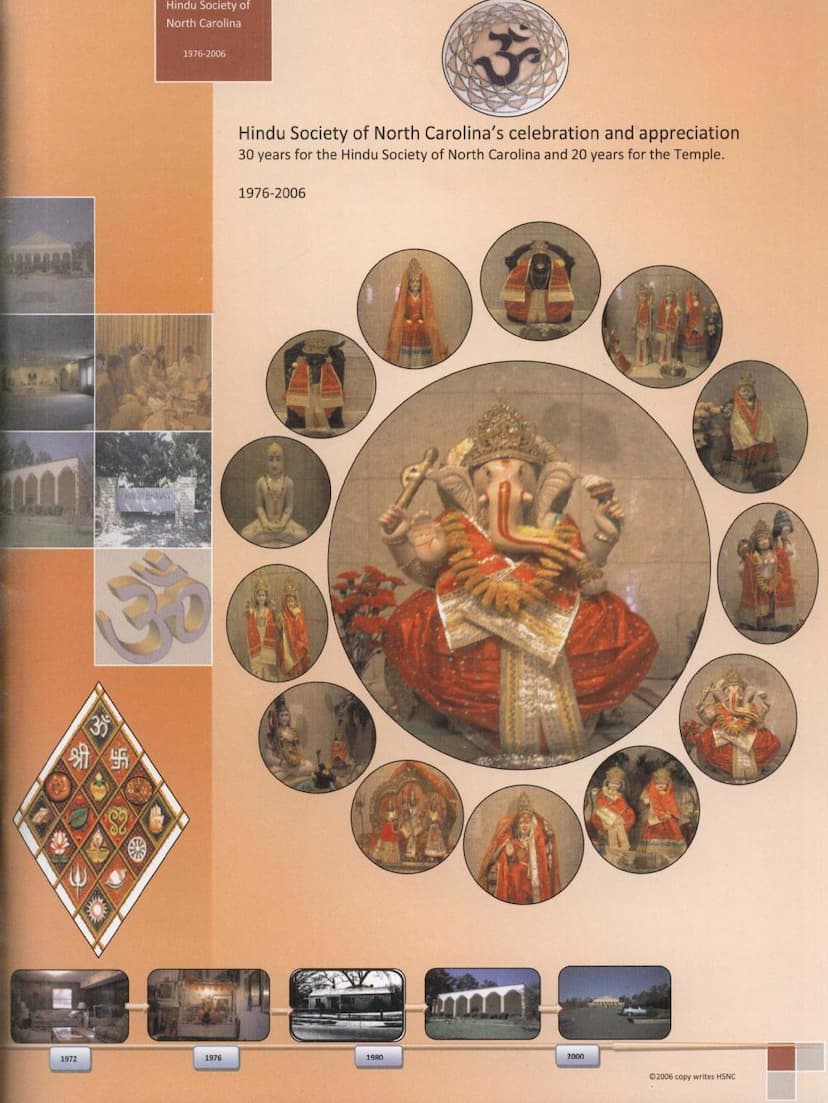Hindu Society Of North Carolina
Added to library: September 1, 2025

Summary
This document is a commemorative publication from the Hindu Society of North Carolina (HSNC), celebrating its 30th anniversary (1976-2006) and the 20th anniversary of its temple.
Here's a comprehensive summary:
Overview: The publication details the history, achievements, and community involvement of the Hindu Society of North Carolina from its inception in 1976 to 2006. It highlights the dedication of its founders, volunteers, and members in establishing and growing the society and its temple, serving as a central hub for the Hindu community in the Research Triangle area of North Carolina.
Key Themes and Content:
-
Founding and Growth:
- The HSNC was founded in 1976 by a small group of Indians who desired to establish a religious and cultural center.
- Dr. G.D. Sharma and Mrs. Saroj Sharma are recognized as pivotal figures and founders, initiating religious gatherings in their home even before the formal establishment of the society.
- The organization's journey involved several milestones:
- Formation of the Geeta group.
- Observing various Hindu festivals in community halls.
- Formalizing the group as The Hindu Society of North Carolina in 1976.
- Purchasing the first building, "Hindu Bhavan," on Ashe Avenue in Raleigh in 1980.
- Acquiring a six-acre plot in Morrisville in 1984.
- Inaugurating the new temple at Morrisville on December 20, 1986.
- Constructing a cultural hall in 2000.
- Expanding the community property to over 14 acres, including residences for priests.
-
Leadership and Governance:
- The publication lists the Board of Directors and Presidents of HSNC from 1976 to 2006, showcasing the consistent leadership and dedication of various individuals. Dr. G.D. Sharma and Mrs. Saroj Sharma appear frequently in leadership roles.
- Various committees are detailed, such as Finance, Fundraising, Membership, Religious, Senior Citizen, and Youth Committees, illustrating the organized structure of the society.
- Contact information for board members and committee chairs is provided.
-
Community Contributions and Recognition:
- Founders and Guarantors: The document acknowledges the founders and loan guarantors who took financial risks to secure the HSNC properties.
- Significant Donors and Consistent Volunteers: Lists of individuals and families who made significant financial contributions and those who consistently volunteered their time and efforts are prominently featured.
- Influences and Education:
- The publication emphasizes the role of HSNC in preserving and promoting Hindu culture and traditions, especially for the younger generation born in America.
- Various classes and programs are highlighted, including Hindi classes, Marathi classes, Vedic Heritage classes, Yoga, and Gita study groups.
- The document also touches upon the broader influence of the Indian community on American society, covering changes in dietary habits, the increased visibility of Indian culture through dance and festivals, and the growing participation of Indians in American politics and professions.
-
Religious and Cultural Activities:
- The temple schedule is outlined, detailing daily aartis, special events, and pujas for various deities.
- The publication includes descriptions of prominent Hindu deities like Lord Ganesh, Lord Venkateswara, Lord Rama, Sita, Lakshman, Lord Krishna, Radha, Hanuman Ji, Goddess Durga, Goddess Lakshmi, and Lord Shiva, along with their symbolism and significance.
- It also includes various Hindu prayers and Aarti chants, such as "Jai Jagdish Hare," "Aarti Kije Hanuman Ji Ki," and "Jai Lakshmi Mata."
-
Community Properties:
- The publication details the HSNC's community properties, including the Hindu Bhavan Temple, the cultural hall, parking areas, and the residences for priests.
-
Member Testimonials and Vision:
- Several members share their thoughts, experiences, and wishes for the future of HSNC, often expressing gratitude for the founders and the organization's role in their lives.
- Common themes in these testimonials include the importance of passing down cultural heritage to children, the society's inclusive and cosmopolitan nature, and the hope for continued growth and community engagement.
Overall Purpose: This publication serves as a testament to the dedication, hard work, and vision of the Hindu community in North Carolina. It chronicles the journey of establishing a significant religious and cultural institution, celebrating the achievements and contributions of its members over three decades, and setting a foundation for future growth and engagement.